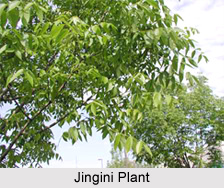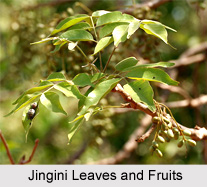 Jingini is a deciduous Indian medicinal plant which is found throughout the greater part of India to an altitude of 1500 metre, in sub-Himalayan "sal" dominated forests. The density of the plant is witnessed in the mixed deciduous forests of the hills and plains, particularly in dry locales. It is often planted as an avenue tree and sometimes serves the purpose for marking field boundaries.
Jingini is a deciduous Indian medicinal plant which is found throughout the greater part of India to an altitude of 1500 metre, in sub-Himalayan "sal" dominated forests. The density of the plant is witnessed in the mixed deciduous forests of the hills and plains, particularly in dry locales. It is often planted as an avenue tree and sometimes serves the purpose for marking field boundaries.
Different Names of Jingini
The botanical name of Jingini is "Dialium Coromandelicu" and it is commonly known as "Indian Ash Tree", "Moya" and "Wodier". This plant is generally famous as "Jiyol" in West Bengal, "Jia" in Assam, "Kalasan" in Tamil Nadu, "Indramati" in Orissa, "Mavedi" in Gujarat, "Shinti" or "Moi" in Maharashtra, "Godda" in Karnataka and in Sanskrit it is called "Jingini".
Characteristic Features of Jingini
The size of Jingini varies from medium to large, growing upto 14m tall. It is deciduous tree with a spreading crown and stout branches. Branchlets are minutely covered with starry hairs. The colour of the bark is grey or whitish. It is smooth, exfoliating in irregular and has rounded plates. The leaves are alternately arranged pinnate and are of 25 to 45 cm in length and are crowded at the ends of branches. There are 7 to 9 leaflets and are oblong-ovate. They are 7.5 to 15 cm long and 2.5 to 5 cm wide. The flowers are small, yellowish or greenish in colour and unisexual. The male flower is fascicled, in slender compound racemes; female flower is in simple pubescent racemes. The colour of the fruits are red, compressed, kidney shaped and are single seeded. The plant bears flowers and fruits between February and June in western central Indian deciduous forests. The trees get leafless between November and December and in June.
 Medicinal Uses of Jingini
Medicinal Uses of Jingini
The bark of Jingini is acrid and has the properties of astringent. The bark is used to prepare a lotion for relieving bruises, wounds, sores, ulcers and sore eyes. The fresh juice of the bark is used externally to relieve sore eyes and to promote the healing of obstinate ulcers. The gum derived from the plant is known as "Jingini Gum", which is given in the treatment of asthma. This gum is also considered as a cordial to women during lactation. The bark has stimulant properties and that can be used as the curative product for gout. It is used in the form of a decoction for gargle to cure mouth ulcers (aphthae) and toothache.
A dilute decoction of the bark of the Indian medicinal plant Jingini is used as an expectorant among the tribal inhabitants of western Maharashtra. The dried, powdered bark, mixed with Neem oil is regarded as an application for chronic ulcers and skin diseases such as impetigo. The leaves of the plant are boiled in oil and applied to relieve sprains and bruises, local swellings, body pains and to relieve elephantiasis. For the treatment of rheumatism the paste of the leaves is mixed with black pepper and the paste is applied externally. In Bengal, the juice of the green branches of Jingini is given as an emetic in cases of coma or insensibility produced by opium or other narcotics. In Ayurveda, the bark and resin of Jingini are used to treat wounds, cardiac disease and diarrhoea. It is also often used for treating the diseases of the nervous system.



















